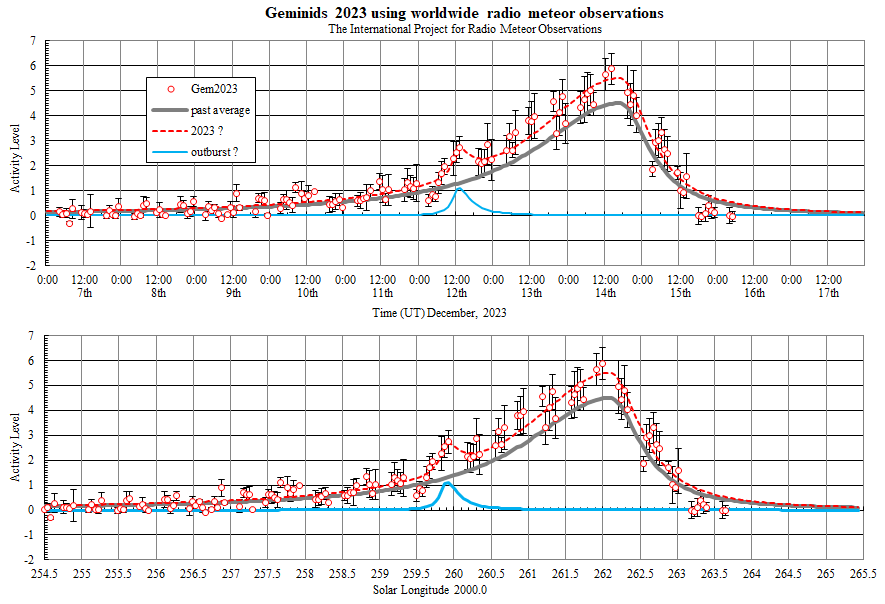The Latest Information of Geminids 2023
This page provided the latest information of Geminids 2023 using worldwide radio meteor observations. This information was published by Hiroshi OGAWA and Hirofumi SUGIMOTO (Japan).
[Attention] Please reflesh this page using Ctrl+F5 key when you see the latest information.
Estimated ZHRr
The following graph is provided by Mr.Hirofumi SUGIMOTO in Japan. This is calculated by using factors of Geminids (radiant point etc.).
- In this year, a chance to observe meteors released from 46P/Wirtanen. Around a predicited peak time (λ⊙=260°.1), radio observing stations detected unusual activity. Of course, it has a possibillity that this increase was caused by 46P/Wirtanen, but, there is also a possibility of Geminid suprised outburst because this graph use factors of Geminids.
We are calculating, analyzing and discussing now.

- 41 observed data.
- radiant information : Geminids
- CHR_r means the number of meteors subtracted sporadics from total.
- ZHR_r = CHR_r * 1/sin(h) (h:radiant elevation),(excluding h < 20deg.)
- The sporadic meteor is calculated from past data.
- Sugimoto H. (2017). “The New Method of Estimating ZHR using Radio Meteor Observations”. eMetN, 2,109–110.
Activity Level information
The following graph is provided by IPRMO (this project, Hiroshi Ogawa). A gray line means a past average for ten years. A red dashed line is estimated profile of 2023 Geminids using observed “Gem2023" data. A blue line shows a possibility of some outburst.
- As same as ZHRr, this is calculated by using factors of Geminids (radiant point etc.). Therefore, we have to anlyze data in the case of factors of Geminids. We are not sure whether this increase was caused by a dust trail released from 46P/Wirtanen or not. It is also a possibility of a Geminid surprised outburst. We are calculating, analyzing and discussing now.

- 33 observed data in 13 countries.
- Ogawa H., Toyomasu S., Ohnishi K., and Maegawa K. (2001). “The Global Monitor of Meteor Streams by Radio Meteor Observation all over the world”. In, Warmbein Barbara, editor, Proceeding of the Meteoroids 2001 Conference, 6-10 August 2001, Swedish Institute of Space Physics, Kiruna, Sweden. ESA Publications Division, European Space Agency, Noordwijk, The Netherlands, pages 189–191.
Thank you for worldwide radio meteor observers !
This latest information was provided by worldwide radio meteor data published on Radio Meteor Observation Bulletin (RMOB)